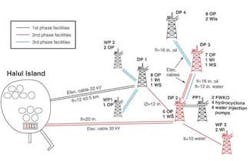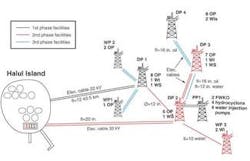Total boosting production from Al-Khalij, driving Dolphin gas plan forward
First production set for 2006
Jeremy Beckman
Editor, Europe
Qatar is looking to lift its production of offshore oil and step up exports of gas from the giant North field. Total is providing assistance on both counts, through expansion of its Al-Khalij development in offshore block 6 and through its technical involvement in the Dolphin project, which will transport gas from northern Qatar across the Persian Gulf to the United Arab Emirates.
Elf Aquitaine (long since integrated into Total) was appointed 100% operator of block 6 in 1989, farming out 45% to Agip in 1991. Very soon afterward, the partners discovered Al-Khalij with their first exploration well, in 58 m of water. Seven appraisal wells followed. At the time, the field was considered Qatar's most important find since 1971.
"However, it was also a complex, stratigraphic trap, which took a long while to delineate," says Total's business development manager for Qatar, Christian Bladier. "Al-Khalij's oil is accumulated on the slope of a monocline and trapped through a lateral variation of the reservoir rock facies. The reservoir consists typically of a vertical succession of 20-30 ft sequences, each containing an alternation of poor permeability intervals (non-drains) and high productive layers. At the beginning, we had serious concerns over the size of the reservoir. Also, as most of the accumulation was located in the oil-water transition zone, this meant that the wells would produce quite a lot of water."
Due to uncertainty over long-term prod-uction performance, the partners opted in 1995 for a phased development, focusing initially on the field's central section.
The first development phase included three unmanned platforms, all built by platform fabricator NPCC in Abu Dhabi: one 10-slot, 1,600-metric-ton wellhead installation, and two remote, three-slot, 500-metric-ton well protector tripods. The wellstream was piped 42 km through a 12-in. multiphase pipeline for gas-oil-water separation at Halul Island, the latter facilities also supplied by NPCC. Additionally, a 5.6-MW electric cable was laid to connect the wellhead platform to Halul. Produced crude was stored and produced water further de-oiled at the existing Qatar Petroleum process terminal.
The wellhead platform's minimal facilities included chemical injection equipment, a multiphase flowmeter, and a power distribution system for the downhole electric submersible pumps (ESPs) in the production wells, supplied by Centrilift.
"ESPs were required for phase two as well," Bladier says, "due to the low gas-oil-ratio of 232 cf/bbl of the associated gas. The crude has an API of 28°."
null
Improved analysis
When production started in March 1997, six wells were onstream, all with horizontal drains, with output climbing by 1998 to 30,000 b/d. A further six wells were drilled through 1988-99, some being re-entries of delineation wells, and a pilot water injection scheme was also started in 1999. That December, a second development phase was authorized in the southeastern section of Al-Khalij, designed to raise production capacity to 50-60,000 b/d by mid-2002.
By that point, Bladier says, understanding of the reservoir had improved due to a combination of production experience and analysis of a new 3D seismic survey acquired at the end of 1998. The Phase 2 plan called for two large, 10-slot platforms and one remote tripod, which NPCC built in Abu Dhabi. This time around, Reda supplied the ESPs for the wells. A 20-in. multiphase line was also installed.
"At the end of 2000, we were already thinking of a third phase, in the northeastern part of Al-Khalij," Bladier says. To appraise this part of the field, a 4.5-km extended-reach well was drilled earlier that year from the existing platform, followed by an extended production test through to October. A second well was drilled and tested mid-2001, followed by detailed geological and reservoir modeling.
"The Qatar government was very supportive, and was always pushing us to go further," adds Total Middle East Exploration and Production Vice President Jean-Francois Arrighi de Casanova. The government was anxious to address a decline in Qatar's oil production, anticipated from 2007 on.
Phase 3 was approved in June 2002 (the previous month, Agip exited the project after deciding the field was outside its strategic interest). This $150-million plan, designed to raise production capacity to 80,000 b/d, involves the addition of a new 15-slot, 2,600-metric-ton wellhead platform, and a 2,500-metric-ton process platform, both built by NPCC, designed solely for water separation. Produced water will be injected back into the reservoir at up to 125,000 b/d.
"We are installing a dedicated process platform for the first time on this project," Bladier explains, "because we want to decrease substantially the quantity of water sent to Halul Island, partly at the request of Qatar Petroleum (QP). Also, there are environmental benefits in putting such large quantities of water back into the reservoir. Up till now, all Halul Island's produced water has been treated to reduce the oil content as much as possible before the water is put back into the sea. A new reinjection scheme is under way there also."
Since the start of 2002, all Al-Khalij's associated gas has been recovered and used as fuel gas for new power generation facilities owned and operated by QP. Phase 3 should be onstream in mid-2004.
Additionally, Total was granted the rights to appraise a suspected extension of the field located north of block 6 and close to the median line with Iran. An appraisal well is due to be drilled there this year. If successful, development would follow from the new wellhead platform, probably via three production wells and one injector.
"We have also decided recently to drill further wells elsewhere on Al-Khalij," Bladier said. Total has a 25-year production contract for block 6, which is currently valid through 2013. However, known reserves have enough potential to sustain production until at least 2025.
Dolphin surging ahead
In the North field, Total is a partner in the Bravo production block operated by Qatargas and developed by Total in the mid-1990s on QP's behalf. Here, the production plan includes three wellhead platforms with 20 wells, two process/utilities platforms with gas-condensate-water separation, gas and water treatment, and a living quarters platform. The gas and condensate are sent through a single 32-in. sea line to Ras Laffan, northeast Qatar for further treatment and gas liquefaction.
null
Total also has a 10% interest in the Qatargas liquefaction plant. Qatargas currently produces up to 7.7 million metric tons a year of LNG and 50,000 b/d of condensate from three trains. A project is in progress to raise the capacity to 9.5 MM metric tons/yr by 2005.
In December 2001, Total signed a production sharing contract with QP involving the sale of 2 bcf/d of gas from the North field to the United Arab Emirates over a 25-year period, starting 2006. The $3.5-billion project, known as Dolphin, is operated by Dolphin Energy Ltd., owned by the Abu Dhabi-based UAE Offsets Group (51%). Total (24.5%) is contributing to the project through its technical knowledge of the North field. The other partner, Occidental Petroleum, also with 24.5% interest, was brought onboard in May 2002, a year after Enron, one of the original partners, pulled out. Occidental also operates oil production offshore Qatar.
Gas will be developed using two identical wellhead platforms, featuring chemical injection and test facilities, each producing 1.25 bcf/d of gas. Supplies will be piped initially through two 36-in. sea lines (one for each platform) 80-90 km southwest to Ras Laffan for treatment.
DEL plans a multiphase "wet" scheme, similar to what Total implemented in South Pars II offshore Iran, where incoming wet gas is separated at the treatment center in Assaluyeh. The gas will then head east through a new 48-in., concrete-coated 380-km pipeline across the Persian Gulf to the Taweelah terminal in Abu Dhabi. A riser platform will also be installed.
Taweelah has the Emirates' heaviest concentration of gas-fired turbines for power generation and seawater desalination plants; however, the export line will be designed for throughput of up to 3 bcf/d, as supplies from Dolphin will probably trigger construction of new facilities elsewhere in the UAE. With this in mind, an offshore or overland spur line may also be laid from Taweelah to another part of the Emirates.
Sofresid in Paris and Foster Wheeler have been managing front-end engineering design for the platforms and basic engineering for the treatment terminal in Ras Laffan. Kellogg Brown and Root is responsible for engineering of the pipelines. Installation contracts have yet to be awarded. Maximum water depth along the main pipeline route is 50-60 m.
"The main technical challenge," says Total's joint venture manager, Laurent Maurel, "is the quantity of existing flowlines that have to be circumvented."
Construction and installation work should start in 2004, followed by first production two years later.


